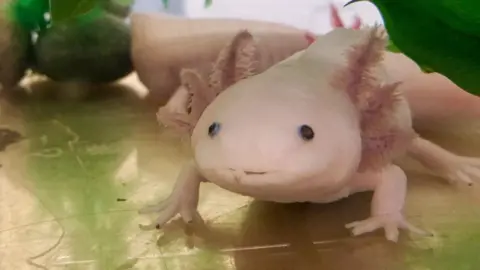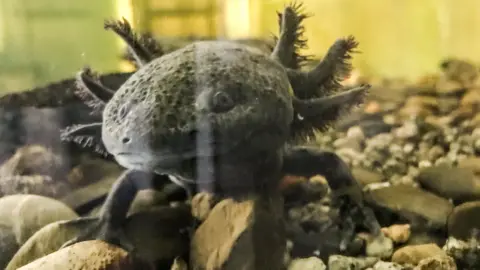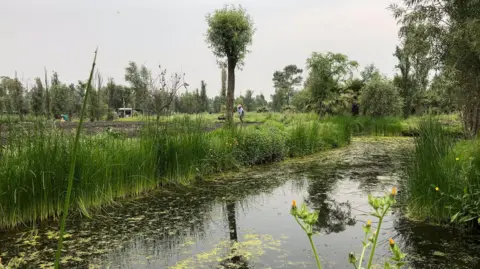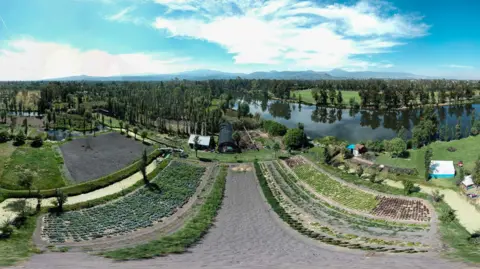Science correspondent
 Victoria Gill/BBC News
Victoria Gill/BBC NewsOne of the world’s most endangered amphibians – the strange, perpetually smiling Mexican axolotl – has thrived after being released in artificial wetlands, scientists have discovered.
In a study that provides hope for the long-term future of a creature that was pushed to the brink of extinction, scientists released 18 captive-bred axolotls in restored and artificial wetland close to Mexico City.
The researchers fitted the animals with radio trackers and found that they “survived and foraged successfully at both sites” – even gaining weight.
Lead researcher Dr Alejandra Ramos from the Autonomous University of Baja California said this was an “amazing result”.
 Victoria Gill, BBC News
Victoria Gill, BBC NewsThe findings are published in the journal PLoS One and they suggest, the researchers say, that the axoltol can be brought back to its native habitat.
The waters of Xochimilco – shaped by traditional farming practices and flushed with spring water from the mountains – used to teem with these amphibians.
But as Mexico City grew, urbanisation, pollution and other pressures pushed axolotls to the brink of extinction, with some estimates suggesting that there were as few as 50 left in the wild.
“If we lose this species, we lose part of our Mexican identity,” said co-lead researcher Dr Luis Zambrano from the National University of Mexico.
It is no exaggeration to call the axoltol an icon. Aztec legend has it that the creature is a god in salamander form – the Aztec god of fire and lightning, Xolotl, disguised as a salamander.
“If we can restore this [wetland] habitat and restore the axolotl’s population in a city of more than 20 million people,” Dr Zambrano continued, “I feel that we have hope for humanity.”
 Victoria Gill, BBC News
Victoria Gill, BBC NewsTo lay the foundations for releasing the animals, the researchers worked with local farmers and a team of volunteers to create wetland “refuges” for the axolotls. They installed natural filtering systems to clean the water,
The scientists released their captive-bred animals at two sites – one in Xochimilco and one at a disused quarry that, over decades, has turned into what they called an “artificial wetland”.
Every animal was tagged with a radio tracking device.
“The amazing news is that they all survived,” Dr Ramos told BBC News. “And not only that, but the ones that we recaptured had gained weight – so they’re hunting.”
The monitoring also revealed intriguing insights into axolotl behaviour. “We found that some spend most of their time with one other individual – like they make these little friendships,” Dr Ramos explained.
 Victoria Gill/BBC News
Victoria Gill/BBC NewsSomewhat ironically, these charismatic salamanders are found in the world’s laboratories and pet aquariums in their hundreds of thousands. The species is biologically fascinating – it has the remarkable ability to regrow any part of its body that is damaged or lost. So there is research underway to understand whether that ability could be harnessed medically.
But in the murky wetlands of Mexico City, there is still a great deal of work to do to clean up and restore the habitat, and to give the wild axolotl a chance to recover.
“Many animals are losing their habitat around the world,” said Dr Ramos. “And restoration projects are not easy, but they can be done – they just need a lot of people.
“You don’t need to be a scientist to get involved – everybody in the world can help out.”
 David Schneider
David Schneider


